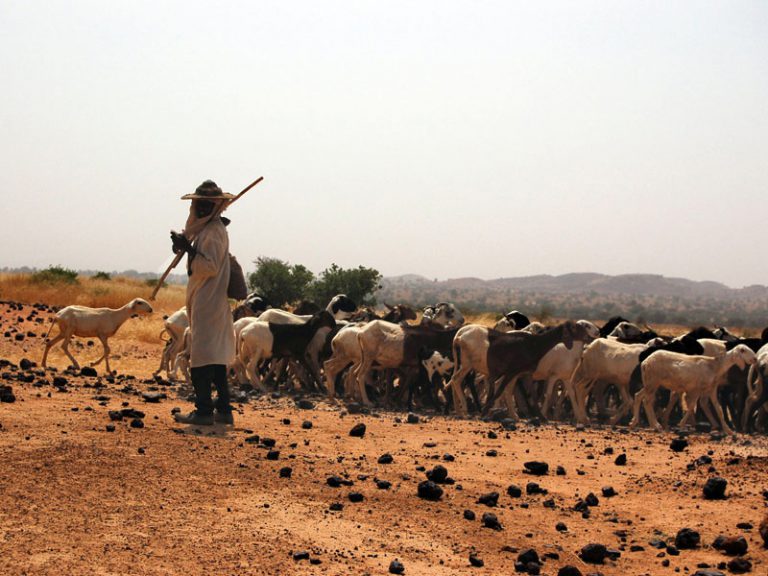Pastoral livestock herding has long been blamed for contributing to environmental degradation1 and especially to biodiversity loss. Is this criticism warranted given that pastoralism is still—and has long been—a key economic activity in Sahelian-Saharan Africa? Preconceived ideas or reality? These questions are addressed hereafter…
(1) Steinfeld H. et al. 2006. Livestock’s long shadow: environmental issues and options. FAO, Rome, 390 p.
An economic activity tailored to dryland areas
Pastoralism is a form of livestock farming based on continuous or seasonal, local or regional herd mobility. This livestock rearing strategy is geared towards meeting the herd’s nutritional needs via intermittent grazing of fodder resources of often spatiotemporally varying availability and quality.
In Sahelian-Saharan areas, pastoral livestock farming is family-based, devoted to cattle breeding and production, and secondarily to milk production. This major economic activity accounts for an average 38% of the agricultural GDP of the concerned countries (Ickowicz A. et al., 2012. Crop-livestock production systems in the Sahel: increasing resilience for adaptation to climate change and preserving food security. In: Meybeck et al. (eds), Building resilience for adaptation to climate change in the agricultural sector. Proc. of FAO/OECD workshop 23-24 April 2012: 261-294.) chain right up to urban and coastal consumers. Moreover, it is a way of managing ecosystems and safeguarding the social structure and culture.
Pastoralism – a complex system
“The question is not to determine whether ‘pastoralism is ecologically viable or not!’ Pastoralism is not an academic discipline and the problem is not to rank it within any discipline, i.e. ecology. Nevertheless, we researchers will only be able to understand this phenomenon by studying it through a diversity of approaches, including an ecological one. It is necessary to focus on: dynamics (seasons, multiannual cycles); interactions (between humans and the environments, between humans and animals, between animals, between animals and plants, between plants when they are subjected to grazing); diversity (of animal and plant species and physiological stages); temporal aspects (animal growth rates, plant restoration cycles, human activity patterns).”
From Toutain et al., 2012.
Pastoralism and biodiversity – multiple relationships
It is often claimed that ‘overgrazing’ by pastoral livestock herds is responsible for biodiversity loss due to a livestock load vs fodder supply imbalance. Yet this overgrazing is difficult or impossible to quantify on generally communal rangelands where multispecies livestock herds roam. Moreover, very little experimental research has been focused on the real short- and medium-term impacts of pastoral livestock herding on Sahelian ecosystems, and the findings of the few trials that have been carried out on productivity and plant diversity are contradictory (Hiernaux P., 1998. Effects of grazing on plant species composition and spatial distribution in rangelands of the Sahel. Plant Ecology, 138: 191-202. Miehe et al., 2010. Long-term degradation of Sahelian rangeland detected by 27 years of field study in Senegal. J. of Appl. Ecol., 47(3): 692-700.).
It is essential to distinguish between:
- short- (seasonal), medium- (interannual) and long-term (decadal) effects
- impacts on annual and perennial grasses, trees and shrubs
- impacts on standing fodder mass, productivity, floristic diversity, soil seed stocks, and the plant species population structure.
In the short term, grazing livestock are involved in three relatively concomitant processes: grazing, trampling, and dung/urine deposition. Livestock also contribute to gas and heat exchange (respiration, enteric venting, etc.). The impacts of these three processes are also highly dependent on the season, and to a lesser extent on the relief and soil texture. Only rainy season grazing has a positive or negative short-term impact on herbaceous plant production, depending on the grazing frequency (thus on the animal load) and timing. Dry season grazing induces in situ recycling of at least two-thirds of the herbaceous fodder mass through trampling, in addition to the urine/dung fraction excreted by grazing animals.
Fodder grazing is always selective in terms of species and plant organs. Cattle will spread this fodder along their roaming pathway, and the choice of fodder will vary between livestock species while also being dependent on the herd management regime. In the medium and long term, pastoral ivestock herding influences the flora and its diversity according to the seasonality, animal load intensity and herd composition. When the load increases, diversity loss is not systematic nor is there an increase in ungrazed plant species. Moreover, a long-term survey of ecosystems involving a comparison of exclosure and grazed areas revealed a slight long-term reduction in plant biodiversity, with enhancement of the pastoral value of grazed areas (Projet d’autopromotion pastorale du Ferlo). Very selective browsing of trees and shrubs has little effect on them, i.e. much less than some human practices (e.g. pruning). Moreover, livestock herds play an important role in seed dispersal.
Livestock farming and wildlife conservation have reciprocal impacts. Extensive mobile livestock herding systems have sporadic impacts on natural resources and make optimal use of an ecological system that is imbalanced, given the climatic conditions in tropical arid and semiarid zones. This type of land use generally offers excellent opportunities for cohabitation with wildlife, with the exception of hunting pressure and the fact that this proximity leads to competition for access to land and resources, as livestock and wildlife occupy often identical ecological niches. Furthermore, cohabitation with wild ungulates is possible and has been observed in many natural or protected areas where the complementary nature of the diets of these ruminants has frequently been documented. The ecology of pastoralism and that of herbivorous fauna are interrelated and compatible.
Sahelian herders, like those on other continents, are aware of predation and will tend to ward off or even drive away carnivores when their herds are threatened. In addition, there is an animal health risk at the wildlife-livestock interface, which can be conducive to the cross-dissemination of pathogens (Binot et al., 2006. L’interface faune-bétail en Afrique subsaharienne. Sécheresse, 17(1-2): 349-361.).
Recommendations for pastoral livestock herding
• Facilitate seasonal herd mobility by adapting to seasonal and interannual variations in pastoral resources (water and fodder) so as to avoid intense grazing during the vegetation growth season and the heavy burden of sedentary herds.
• Provide the widest possible access to rangelands and watering places for livestock: concerted community-based rangeland management, including postharvest stubble.
• Joint investment in water, rangeland management (herd trails, pastoral resting places and reserves), veterinary and commercial infrastructure.
• Limit rangeland privatization in the northern Sahel which is inconsistent with necessary herd movements.
• Invest in decentralized education and health services in pastoral areas.
• Promote linkages between pastoral stockbreeding and specialized sedentary livestock farms in periurban and subhumid areas (marketing, contracts).
• Support socioprofessional livestock farming associations and foster the empowerment of their members in negotiations for access to resources and in professional training.
• Develop new collaborative approaches to wildlife management, with the participation of herding communities, on wildlife conservation in pastoral areas and on the fringes of protected areas.
• Involve pastoralists and local actors in the participatory restoration of degraded Sahelian ecosystems (especially trees and shrubs).
For further information :
Assouma M.H. et al., 2018.How to better account for livestock diversity and fodder seasonality in assessing the fodder intake of livestock grazing semi-arid sub-Saharan Africa rangelands. Livest. Sc., 216: 16-23.
Bonnet B. et al., 2005. Hydraulique et sécurisation des systèmes pastoraux au Sahel. Appui à la gestion locale. Démarches et méthodes, Iram, Paris, 28 p.
Boutrais J., 1990. Derrière les clôtures… Essai d’histoire compare de ranchs africains. ORSTOM Cah. des sc. Hum., 26(1–2): 73–95.
Thebaud B. et al., 1995. Recognizing the effectiveness of traditional pastoral practices: lessons from a controlled grazing experiment in Northern Senegal. Drylands Issues Paper, 55, IIED, London.
Toutain B. et al., 2012.Pastoralism in dryland areas. A case study in sub-Saharan Africa. Les dossiers thématiques du CSFD. 9. CSFD/Agropolis International, Montpellier, France. 60 p. (Download)




